MG411: Introduction to People Management Report on NHS - Dec 2019
VerifiedAdded on 2023/01/19
|11
|2536
|45
Report
AI Summary
This report provides an in-depth analysis of people management within the National Health Service (NHS). It explores key theoretical models, including contingency theory and expectancy theory, and their application to leadership, management, training and development, and talent managemen...
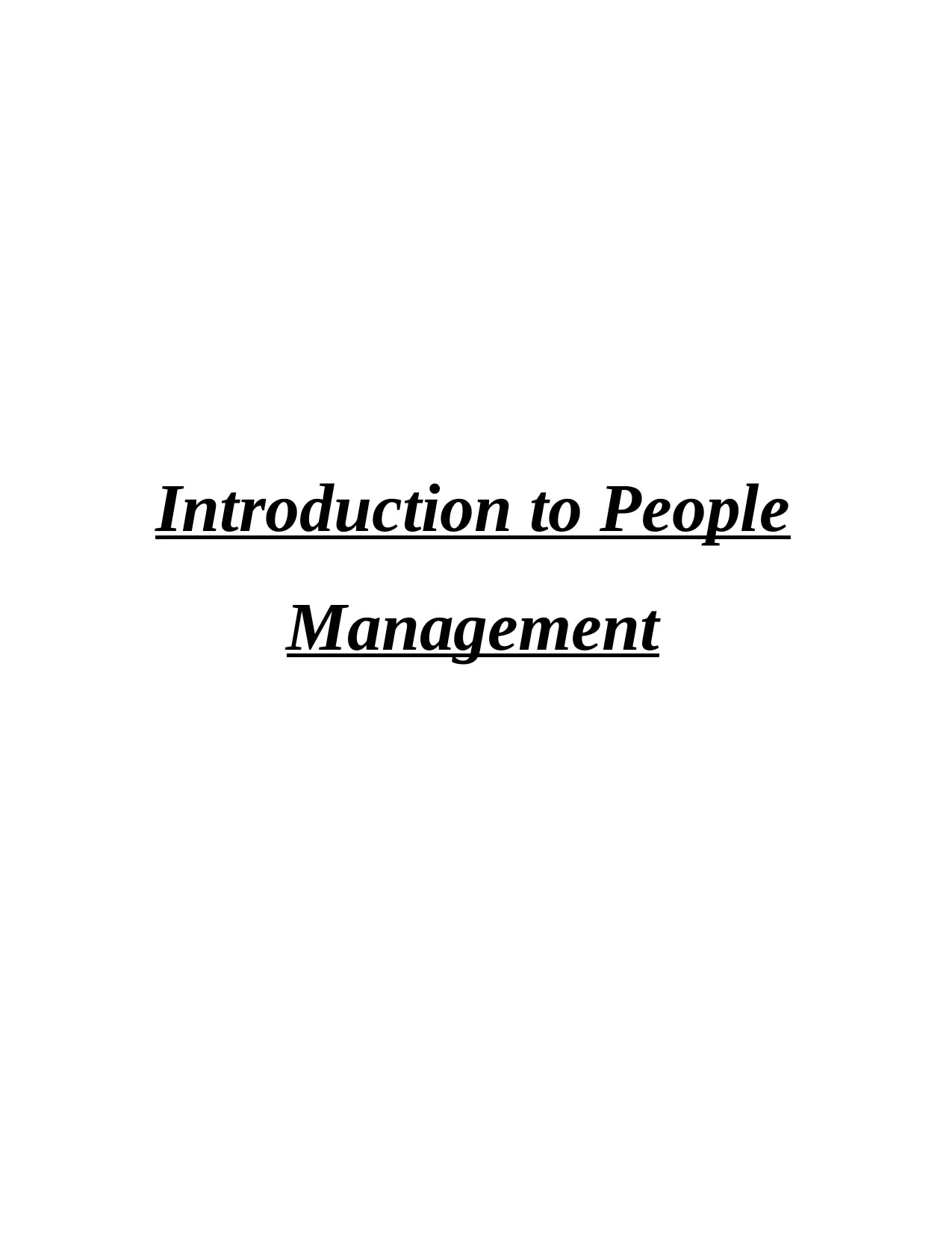
Introduction to People
Management
Management
Secure Best Marks with AI Grader
Need help grading? Try our AI Grader for instant feedback on your assignments.

Table of Contents
INTRODUCTION...........................................................................................................................1
TASK 1............................................................................................................................................1
Key theoretical models as well as their applications..............................................................1
TASK 2............................................................................................................................................2
Roles & Priorities of NHS management................................................................................2
TASK 3............................................................................................................................................3
Different internal as well as external influences on Leadership & management, T&D and
talent management..................................................................................................................3
Recommendations..................................................................................................................5
CONCLUSION................................................................................................................................5
REFERENCES................................................................................................................................7
INTRODUCTION...........................................................................................................................1
TASK 1............................................................................................................................................1
Key theoretical models as well as their applications..............................................................1
TASK 2............................................................................................................................................2
Roles & Priorities of NHS management................................................................................2
TASK 3............................................................................................................................................3
Different internal as well as external influences on Leadership & management, T&D and
talent management..................................................................................................................3
Recommendations..................................................................................................................5
CONCLUSION................................................................................................................................5
REFERENCES................................................................................................................................7
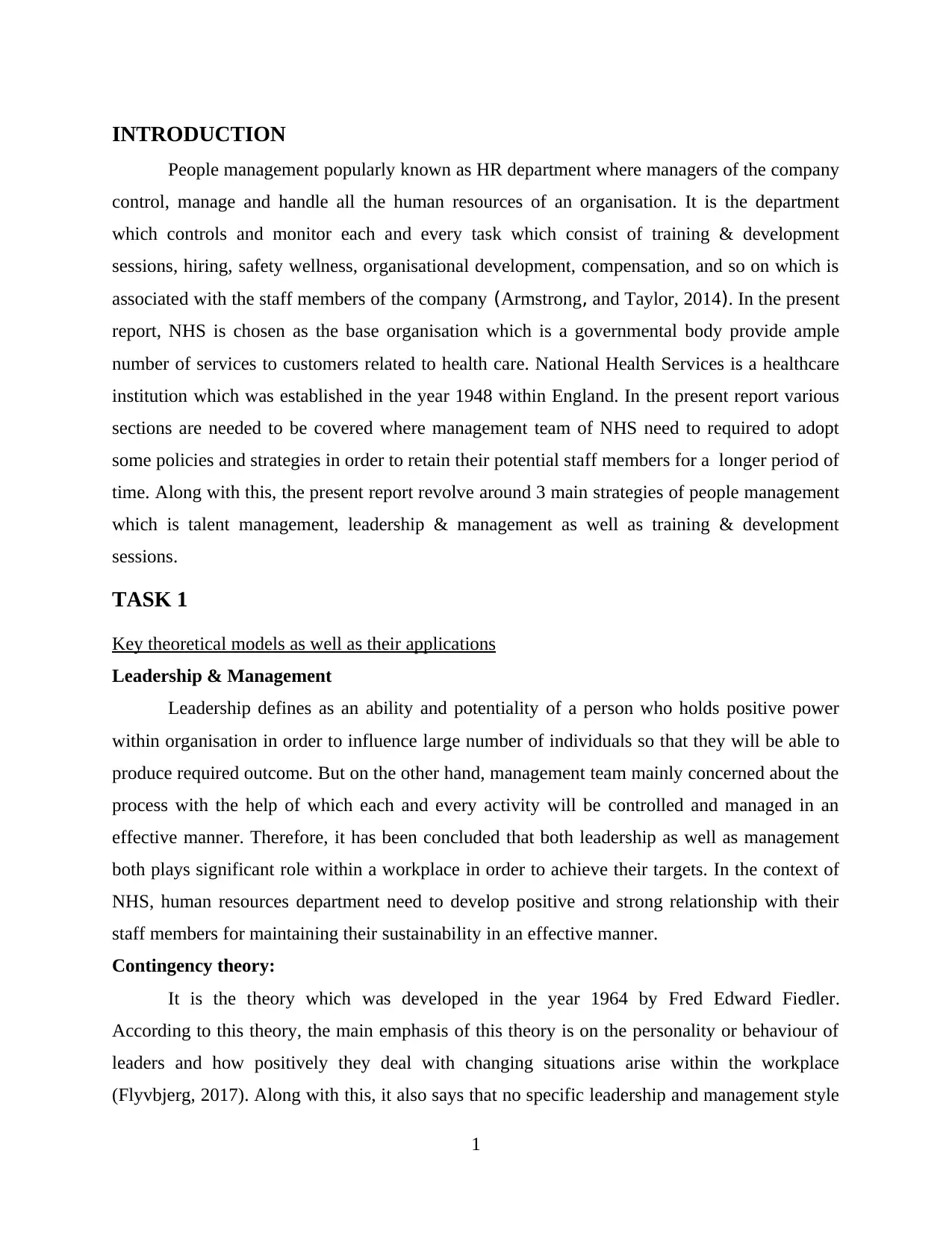
INTRODUCTION
People management popularly known as HR department where managers of the company
control, manage and handle all the human resources of an organisation. It is the department
which controls and monitor each and every task which consist of training & development
sessions, hiring, safety wellness, organisational development, compensation, and so on which is
associated with the staff members of the company (Armstrong, and Taylor, 2014). In the present
report, NHS is chosen as the base organisation which is a governmental body provide ample
number of services to customers related to health care. National Health Services is a healthcare
institution which was established in the year 1948 within England. In the present report various
sections are needed to be covered where management team of NHS need to required to adopt
some policies and strategies in order to retain their potential staff members for a longer period of
time. Along with this, the present report revolve around 3 main strategies of people management
which is talent management, leadership & management as well as training & development
sessions.
TASK 1
Key theoretical models as well as their applications
Leadership & Management
Leadership defines as an ability and potentiality of a person who holds positive power
within organisation in order to influence large number of individuals so that they will be able to
produce required outcome. But on the other hand, management team mainly concerned about the
process with the help of which each and every activity will be controlled and managed in an
effective manner. Therefore, it has been concluded that both leadership as well as management
both plays significant role within a workplace in order to achieve their targets. In the context of
NHS, human resources department need to develop positive and strong relationship with their
staff members for maintaining their sustainability in an effective manner.
Contingency theory:
It is the theory which was developed in the year 1964 by Fred Edward Fiedler.
According to this theory, the main emphasis of this theory is on the personality or behaviour of
leaders and how positively they deal with changing situations arise within the workplace
(Flyvbjerg, 2017). Along with this, it also says that no specific leadership and management style
1
People management popularly known as HR department where managers of the company
control, manage and handle all the human resources of an organisation. It is the department
which controls and monitor each and every task which consist of training & development
sessions, hiring, safety wellness, organisational development, compensation, and so on which is
associated with the staff members of the company (Armstrong, and Taylor, 2014). In the present
report, NHS is chosen as the base organisation which is a governmental body provide ample
number of services to customers related to health care. National Health Services is a healthcare
institution which was established in the year 1948 within England. In the present report various
sections are needed to be covered where management team of NHS need to required to adopt
some policies and strategies in order to retain their potential staff members for a longer period of
time. Along with this, the present report revolve around 3 main strategies of people management
which is talent management, leadership & management as well as training & development
sessions.
TASK 1
Key theoretical models as well as their applications
Leadership & Management
Leadership defines as an ability and potentiality of a person who holds positive power
within organisation in order to influence large number of individuals so that they will be able to
produce required outcome. But on the other hand, management team mainly concerned about the
process with the help of which each and every activity will be controlled and managed in an
effective manner. Therefore, it has been concluded that both leadership as well as management
both plays significant role within a workplace in order to achieve their targets. In the context of
NHS, human resources department need to develop positive and strong relationship with their
staff members for maintaining their sustainability in an effective manner.
Contingency theory:
It is the theory which was developed in the year 1964 by Fred Edward Fiedler.
According to this theory, the main emphasis of this theory is on the personality or behaviour of
leaders and how positively they deal with changing situations arise within the workplace
(Flyvbjerg, 2017). Along with this, it also says that no specific leadership and management style
1

is best suitable for an organisation. Managers and leaders need to modify their strategies,
approaches and policies according to the requirements and on the basis of situations arise at
workplace. It is said that there are mainly two prime outlines of contingency theory which
includes task as well as relationship motivated. In reference to the present context of NHS,
leaders of the organisation need to follow and adapt leaderships styles as per the situation arise
within the workplace. This is the theory which assist the leaders of NHS in order to adopt
dynamic environment in an effective manner and retain their potential employees for long period
of time. Apart from this, it will also help the management team in order to take effective
decisions and enhance the efficiency of staff members (Russ, 2014).
Training & development
It define as the procedure of enhancing and improving the capability and skills of staff
members working at the business entity so that their performance will be increased and assist in
attaining goals and objectives.
Transitional Model: It refers to the model which highly focusses on the whole
organisation. It has been identified that this is the theory which is based on two main loops.
Outer loop is the one which consists of mission, value and vision of the organization but on the
other hand in case of inner loop where every activity is executed. According to transitional
model, managers and leader need to develop training and development session so that new
technologies will be adopted by the staff members in an appropriate manner. In the present
context of NHS, while managers develop their training & development sessions it is very
essential to examine all the factors so that they will be able to gain competitive advantages.
Talent Management
Expectancy theory: It is the theory which was introduced by Victor Vroom. As per this
theory, it has been said that a manager and leader should motivate its staff members so that they
will provide various positive outcomes. For this different types of rewards, benefits and
opportunities should be given to the staff members (Stark, 2015). This as a result assist in talent
management.
2
approaches and policies according to the requirements and on the basis of situations arise at
workplace. It is said that there are mainly two prime outlines of contingency theory which
includes task as well as relationship motivated. In reference to the present context of NHS,
leaders of the organisation need to follow and adapt leaderships styles as per the situation arise
within the workplace. This is the theory which assist the leaders of NHS in order to adopt
dynamic environment in an effective manner and retain their potential employees for long period
of time. Apart from this, it will also help the management team in order to take effective
decisions and enhance the efficiency of staff members (Russ, 2014).
Training & development
It define as the procedure of enhancing and improving the capability and skills of staff
members working at the business entity so that their performance will be increased and assist in
attaining goals and objectives.
Transitional Model: It refers to the model which highly focusses on the whole
organisation. It has been identified that this is the theory which is based on two main loops.
Outer loop is the one which consists of mission, value and vision of the organization but on the
other hand in case of inner loop where every activity is executed. According to transitional
model, managers and leader need to develop training and development session so that new
technologies will be adopted by the staff members in an appropriate manner. In the present
context of NHS, while managers develop their training & development sessions it is very
essential to examine all the factors so that they will be able to gain competitive advantages.
Talent Management
Expectancy theory: It is the theory which was introduced by Victor Vroom. As per this
theory, it has been said that a manager and leader should motivate its staff members so that they
will provide various positive outcomes. For this different types of rewards, benefits and
opportunities should be given to the staff members (Stark, 2015). This as a result assist in talent
management.
2
Secure Best Marks with AI Grader
Need help grading? Try our AI Grader for instant feedback on your assignments.
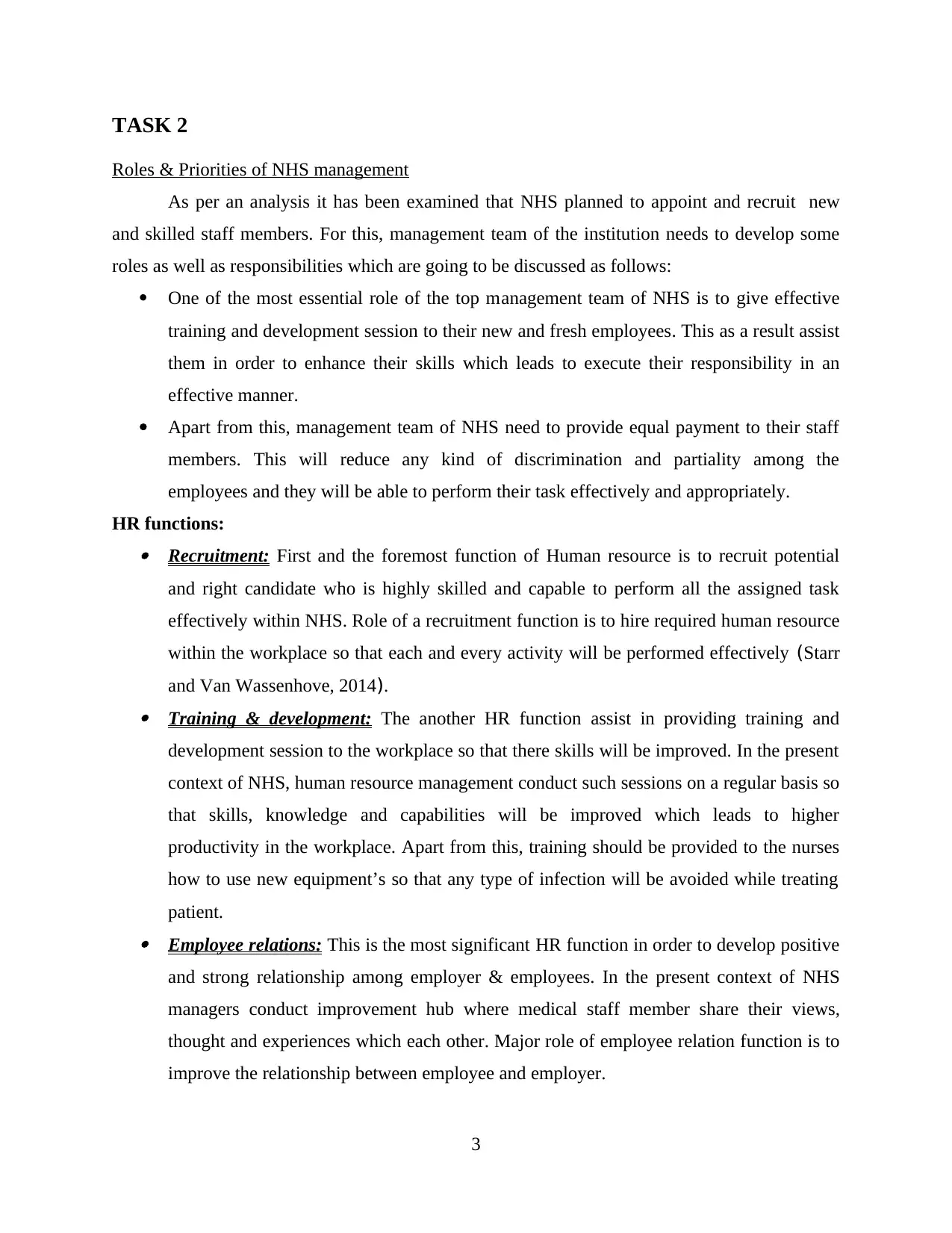
TASK 2
Roles & Priorities of NHS management
As per an analysis it has been examined that NHS planned to appoint and recruit new
and skilled staff members. For this, management team of the institution needs to develop some
roles as well as responsibilities which are going to be discussed as follows:
One of the most essential role of the top management team of NHS is to give effective
training and development session to their new and fresh employees. This as a result assist
them in order to enhance their skills which leads to execute their responsibility in an
effective manner.
Apart from this, management team of NHS need to provide equal payment to their staff
members. This will reduce any kind of discrimination and partiality among the
employees and they will be able to perform their task effectively and appropriately.
HR functions: Recruitment: First and the foremost function of Human resource is to recruit potential
and right candidate who is highly skilled and capable to perform all the assigned task
effectively within NHS. Role of a recruitment function is to hire required human resource
within the workplace so that each and every activity will be performed effectively (Starr
and Van Wassenhove, 2014). Training & development: The another HR function assist in providing training and
development session to the workplace so that there skills will be improved. In the present
context of NHS, human resource management conduct such sessions on a regular basis so
that skills, knowledge and capabilities will be improved which leads to higher
productivity in the workplace. Apart from this, training should be provided to the nurses
how to use new equipment’s so that any type of infection will be avoided while treating
patient. Employee relations: This is the most significant HR function in order to develop positive
and strong relationship among employer & employees. In the present context of NHS
managers conduct improvement hub where medical staff member share their views,
thought and experiences which each other. Major role of employee relation function is to
improve the relationship between employee and employer.
3
Roles & Priorities of NHS management
As per an analysis it has been examined that NHS planned to appoint and recruit new
and skilled staff members. For this, management team of the institution needs to develop some
roles as well as responsibilities which are going to be discussed as follows:
One of the most essential role of the top management team of NHS is to give effective
training and development session to their new and fresh employees. This as a result assist
them in order to enhance their skills which leads to execute their responsibility in an
effective manner.
Apart from this, management team of NHS need to provide equal payment to their staff
members. This will reduce any kind of discrimination and partiality among the
employees and they will be able to perform their task effectively and appropriately.
HR functions: Recruitment: First and the foremost function of Human resource is to recruit potential
and right candidate who is highly skilled and capable to perform all the assigned task
effectively within NHS. Role of a recruitment function is to hire required human resource
within the workplace so that each and every activity will be performed effectively (Starr
and Van Wassenhove, 2014). Training & development: The another HR function assist in providing training and
development session to the workplace so that there skills will be improved. In the present
context of NHS, human resource management conduct such sessions on a regular basis so
that skills, knowledge and capabilities will be improved which leads to higher
productivity in the workplace. Apart from this, training should be provided to the nurses
how to use new equipment’s so that any type of infection will be avoided while treating
patient. Employee relations: This is the most significant HR function in order to develop positive
and strong relationship among employer & employees. In the present context of NHS
managers conduct improvement hub where medical staff member share their views,
thought and experiences which each other. Major role of employee relation function is to
improve the relationship between employee and employer.
3
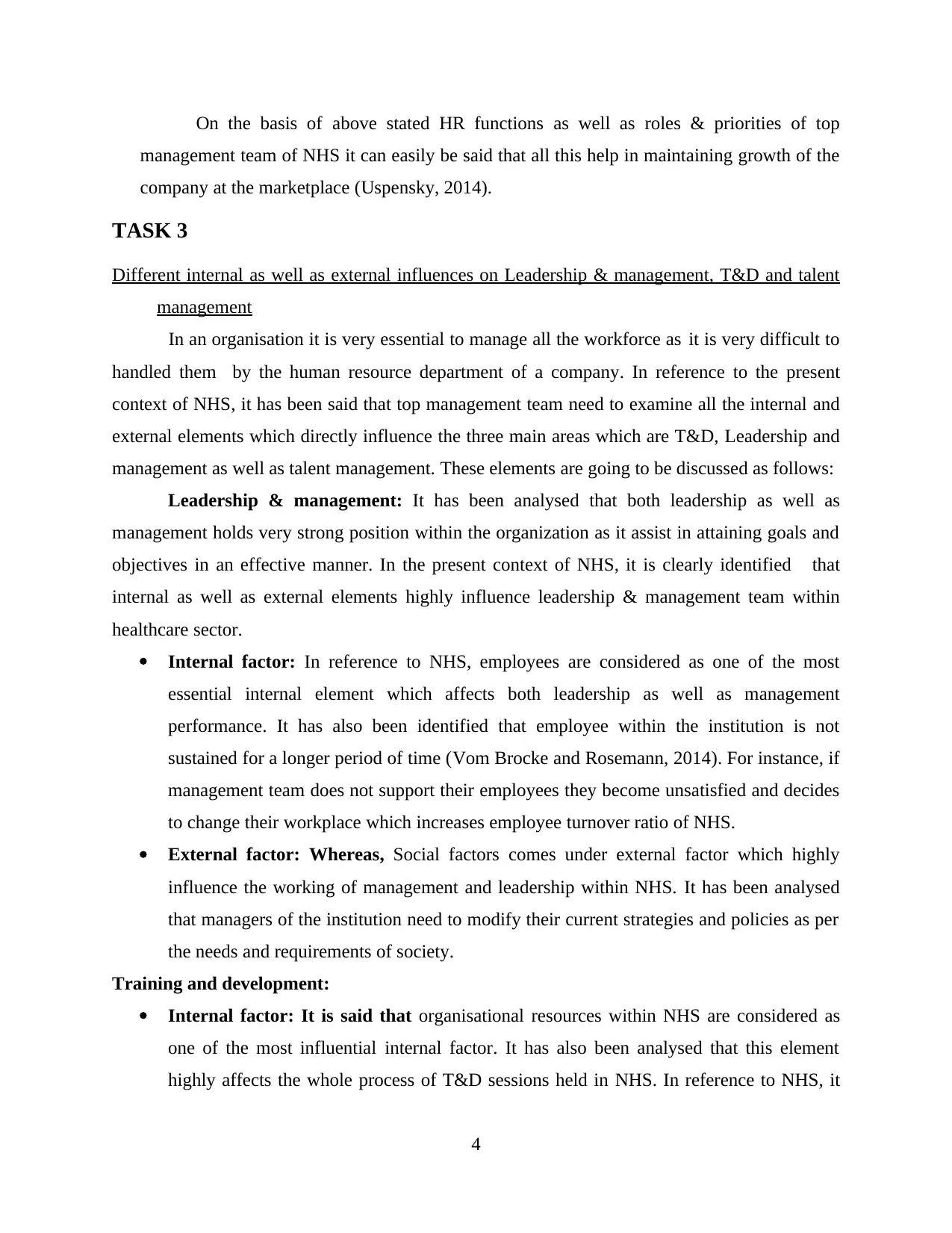
On the basis of above stated HR functions as well as roles & priorities of top
management team of NHS it can easily be said that all this help in maintaining growth of the
company at the marketplace (Uspensky, 2014).
TASK 3
Different internal as well as external influences on Leadership & management, T&D and talent
management
In an organisation it is very essential to manage all the workforce as it is very difficult to
handled them by the human resource department of a company. In reference to the present
context of NHS, it has been said that top management team need to examine all the internal and
external elements which directly influence the three main areas which are T&D, Leadership and
management as well as talent management. These elements are going to be discussed as follows:
Leadership & management: It has been analysed that both leadership as well as
management holds very strong position within the organization as it assist in attaining goals and
objectives in an effective manner. In the present context of NHS, it is clearly identified that
internal as well as external elements highly influence leadership & management team within
healthcare sector.
Internal factor: In reference to NHS, employees are considered as one of the most
essential internal element which affects both leadership as well as management
performance. It has also been identified that employee within the institution is not
sustained for a longer period of time (Vom Brocke and Rosemann, 2014). For instance, if
management team does not support their employees they become unsatisfied and decides
to change their workplace which increases employee turnover ratio of NHS.
External factor: Whereas, Social factors comes under external factor which highly
influence the working of management and leadership within NHS. It has been analysed
that managers of the institution need to modify their current strategies and policies as per
the needs and requirements of society.
Training and development:
Internal factor: It is said that organisational resources within NHS are considered as
one of the most influential internal factor. It has also been analysed that this element
highly affects the whole process of T&D sessions held in NHS. In reference to NHS, it
4
management team of NHS it can easily be said that all this help in maintaining growth of the
company at the marketplace (Uspensky, 2014).
TASK 3
Different internal as well as external influences on Leadership & management, T&D and talent
management
In an organisation it is very essential to manage all the workforce as it is very difficult to
handled them by the human resource department of a company. In reference to the present
context of NHS, it has been said that top management team need to examine all the internal and
external elements which directly influence the three main areas which are T&D, Leadership and
management as well as talent management. These elements are going to be discussed as follows:
Leadership & management: It has been analysed that both leadership as well as
management holds very strong position within the organization as it assist in attaining goals and
objectives in an effective manner. In the present context of NHS, it is clearly identified that
internal as well as external elements highly influence leadership & management team within
healthcare sector.
Internal factor: In reference to NHS, employees are considered as one of the most
essential internal element which affects both leadership as well as management
performance. It has also been identified that employee within the institution is not
sustained for a longer period of time (Vom Brocke and Rosemann, 2014). For instance, if
management team does not support their employees they become unsatisfied and decides
to change their workplace which increases employee turnover ratio of NHS.
External factor: Whereas, Social factors comes under external factor which highly
influence the working of management and leadership within NHS. It has been analysed
that managers of the institution need to modify their current strategies and policies as per
the needs and requirements of society.
Training and development:
Internal factor: It is said that organisational resources within NHS are considered as
one of the most influential internal factor. It has also been analysed that this element
highly affects the whole process of T&D sessions held in NHS. In reference to NHS, it
4

has been said that if there is no enough resources are there within organisation such as
basic equipment, sitting space and many more might hamper the whole process of
training and development.
External factor: On the other hand, if any kind of modifications in healthcare
legislation, topic of training and development session need alterations. For instance, if
there is changes arise within the legal compliance, it is required by the management team
of NHS to provide training sessions related to these laws which might affect the whole
working of an institution (Wild, 2017).
Talent management:
Internal factors: Working environment plays very significant role in order to implement
effective talent management within NHS. It has been said that there are various elements
within the working culture of an organisation which might influence the overall
organization performance. One of the major reason behind working environment of NHS
is recruiting and hiring of individual from agencies so that management team will be able
to reduce issues such as lack of employment. External Factor: Demand & Supply is the another most influential factor which affects
the whole performance of an organization. In the present context of NHS, it has been
analysed that demand of skilled employees are high at the market place. This element
highly influence the whole goodwill as well as market share of the company (Wilton,
2016).
Recommendations
With the assistance of above mentioned report on the topic of people management,
various recommendations need to be given so that sustainability will be maintained in effective
manner. It has been said that NHS required to adopt different strategies and policies with the
help of which they can improve their operations. There are some suggestions made to the
management team of the institution in order to reduce the current manpower issues and
problems. These are the recommendations provided on the basis of three main areas, which are
going to be discussed as follows:
First area in this report is leadership & management and for this it has been
recommended to the top management team of NHS that they should adopt contingency style of
5
basic equipment, sitting space and many more might hamper the whole process of
training and development.
External factor: On the other hand, if any kind of modifications in healthcare
legislation, topic of training and development session need alterations. For instance, if
there is changes arise within the legal compliance, it is required by the management team
of NHS to provide training sessions related to these laws which might affect the whole
working of an institution (Wild, 2017).
Talent management:
Internal factors: Working environment plays very significant role in order to implement
effective talent management within NHS. It has been said that there are various elements
within the working culture of an organisation which might influence the overall
organization performance. One of the major reason behind working environment of NHS
is recruiting and hiring of individual from agencies so that management team will be able
to reduce issues such as lack of employment. External Factor: Demand & Supply is the another most influential factor which affects
the whole performance of an organization. In the present context of NHS, it has been
analysed that demand of skilled employees are high at the market place. This element
highly influence the whole goodwill as well as market share of the company (Wilton,
2016).
Recommendations
With the assistance of above mentioned report on the topic of people management,
various recommendations need to be given so that sustainability will be maintained in effective
manner. It has been said that NHS required to adopt different strategies and policies with the
help of which they can improve their operations. There are some suggestions made to the
management team of the institution in order to reduce the current manpower issues and
problems. These are the recommendations provided on the basis of three main areas, which are
going to be discussed as follows:
First area in this report is leadership & management and for this it has been
recommended to the top management team of NHS that they should adopt contingency style of
5
Paraphrase This Document
Need a fresh take? Get an instant paraphrase of this document with our AI Paraphraser
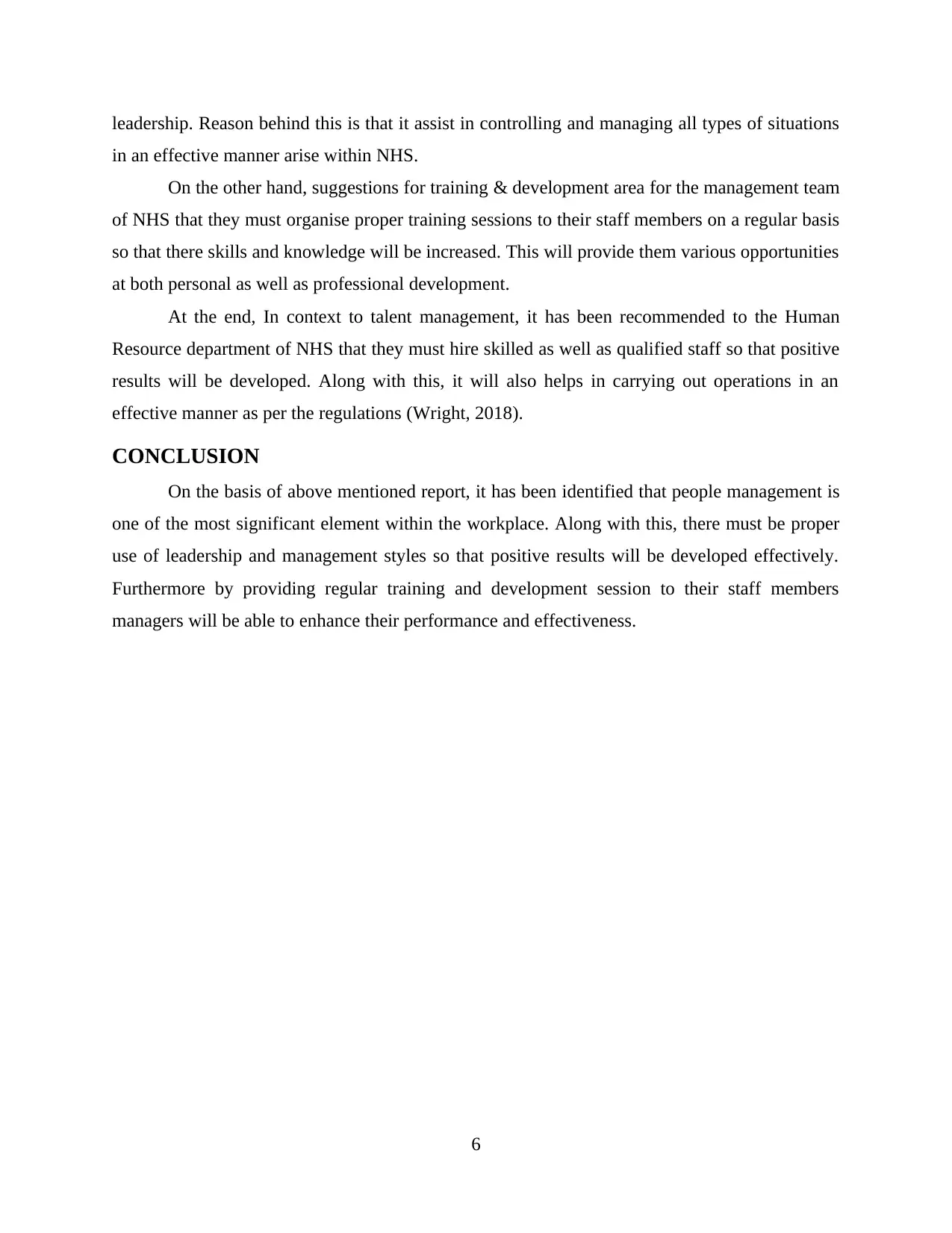
leadership. Reason behind this is that it assist in controlling and managing all types of situations
in an effective manner arise within NHS.
On the other hand, suggestions for training & development area for the management team
of NHS that they must organise proper training sessions to their staff members on a regular basis
so that there skills and knowledge will be increased. This will provide them various opportunities
at both personal as well as professional development.
At the end, In context to talent management, it has been recommended to the Human
Resource department of NHS that they must hire skilled as well as qualified staff so that positive
results will be developed. Along with this, it will also helps in carrying out operations in an
effective manner as per the regulations (Wright, 2018).
CONCLUSION
On the basis of above mentioned report, it has been identified that people management is
one of the most significant element within the workplace. Along with this, there must be proper
use of leadership and management styles so that positive results will be developed effectively.
Furthermore by providing regular training and development session to their staff members
managers will be able to enhance their performance and effectiveness.
6
in an effective manner arise within NHS.
On the other hand, suggestions for training & development area for the management team
of NHS that they must organise proper training sessions to their staff members on a regular basis
so that there skills and knowledge will be increased. This will provide them various opportunities
at both personal as well as professional development.
At the end, In context to talent management, it has been recommended to the Human
Resource department of NHS that they must hire skilled as well as qualified staff so that positive
results will be developed. Along with this, it will also helps in carrying out operations in an
effective manner as per the regulations (Wright, 2018).
CONCLUSION
On the basis of above mentioned report, it has been identified that people management is
one of the most significant element within the workplace. Along with this, there must be proper
use of leadership and management styles so that positive results will be developed effectively.
Furthermore by providing regular training and development session to their staff members
managers will be able to enhance their performance and effectiveness.
6

REFERENCES
Books and Journals
Armstrong, M. and Taylor, S., 2014. Armstrong's handbook of human resource management
practice. Kogan Page Publishers.
Flyvbjerg, B., 2017. Introduction: The iron law of megaproject management. Bent Flyvbjerg,
pp.1-18.
Russ, M., 2014. Introduction—What Kind of an Asset Is Human Capital, How Should It Be
Measured, and in What Markets?. In Management, Valuation, and Risk for Human
Capital and Human Assets (pp. 1-33). Palgrave Macmillan, New York.
Stark, J., 2015. Product lifecycle management. In Product lifecycle management (Volume 1) (pp.
1-29). Springer, Cham.
Starr, M. K. and Van Wassenhove, L. N., 2014. Introduction to the special issue on humanitarian
operations and crisis management. Production and Operations Management. 23(6).
pp.925-937.
Uspensky, I., 2014. Tick pests and vectors (Acari: Ixodoidea) in European towns: Introduction,
persistence and management. Ticks and tick-borne diseases. 5(1). pp.41-47.
Vom Brocke, J. and Rosemann, M. eds., 2014. Handbook on business process management 2:
strategic alignment, governance, people and culture. Springer.
Wild, T., 2017. Best practice in inventory management. Routledge.
Wilton, N., 2016. An introduction to human resource management. Sage.
Wright, P., 2018. Fundamentals of human resource management. Management. 5. p.27.
7
Books and Journals
Armstrong, M. and Taylor, S., 2014. Armstrong's handbook of human resource management
practice. Kogan Page Publishers.
Flyvbjerg, B., 2017. Introduction: The iron law of megaproject management. Bent Flyvbjerg,
pp.1-18.
Russ, M., 2014. Introduction—What Kind of an Asset Is Human Capital, How Should It Be
Measured, and in What Markets?. In Management, Valuation, and Risk for Human
Capital and Human Assets (pp. 1-33). Palgrave Macmillan, New York.
Stark, J., 2015. Product lifecycle management. In Product lifecycle management (Volume 1) (pp.
1-29). Springer, Cham.
Starr, M. K. and Van Wassenhove, L. N., 2014. Introduction to the special issue on humanitarian
operations and crisis management. Production and Operations Management. 23(6).
pp.925-937.
Uspensky, I., 2014. Tick pests and vectors (Acari: Ixodoidea) in European towns: Introduction,
persistence and management. Ticks and tick-borne diseases. 5(1). pp.41-47.
Vom Brocke, J. and Rosemann, M. eds., 2014. Handbook on business process management 2:
strategic alignment, governance, people and culture. Springer.
Wild, T., 2017. Best practice in inventory management. Routledge.
Wilton, N., 2016. An introduction to human resource management. Sage.
Wright, P., 2018. Fundamentals of human resource management. Management. 5. p.27.
7

8
Secure Best Marks with AI Grader
Need help grading? Try our AI Grader for instant feedback on your assignments.

9
1 out of 11
Related Documents
Your All-in-One AI-Powered Toolkit for Academic Success.
+13062052269
info@desklib.com
Available 24*7 on WhatsApp / Email
![[object Object]](/_next/static/media/star-bottom.7253800d.svg)
Unlock your academic potential
© 2024 | Zucol Services PVT LTD | All rights reserved.





